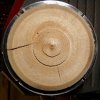Odie
Panning for Montana gold, with Betsy, the mule!
Last night, I was roughing out a spalted Ash bowl, and tiny little hairline cracks were appearing at one isolated spot within minutes of the surface passing a visual inspection. I believe I've heard of this happening before from another turner, but I don't believe I've seen it occur this fast. For me, I've seen this within an hour, or so of removing the bowl from the lathe......if I don't anchorseal immediatly after roughing.
I'll be darned if the cracks returned after resurfacing. Now I was getting to the point where the roughout was getting under the 1/tenth per inch rule. The cracks were small, very small.....but, you know how tiny little cracks often mean failed bowls.:mad:
I took some anchorseal and rubbed it in the cracks with my fingers, and finished the rough out. Did a full anchorseal immediately after removing the roughed bowl from the lathe. It appears as this worked, because I can't detect any cracks this morning......but, I know the little buggers are still hiding in there somewhere!
It wouldn't surprise me if I end up losing this bowl, but my hopes aren't dashed yet.......we'll see how it looks after a few months of seasoning it.
This bowl was around 16-18% moisture content.
What do the rest of you do for this?
ooc
I'll be darned if the cracks returned after resurfacing. Now I was getting to the point where the roughout was getting under the 1/tenth per inch rule. The cracks were small, very small.....but, you know how tiny little cracks often mean failed bowls.:mad:
I took some anchorseal and rubbed it in the cracks with my fingers, and finished the rough out. Did a full anchorseal immediately after removing the roughed bowl from the lathe. It appears as this worked, because I can't detect any cracks this morning......but, I know the little buggers are still hiding in there somewhere!
It wouldn't surprise me if I end up losing this bowl, but my hopes aren't dashed yet.......we'll see how it looks after a few months of seasoning it.
This bowl was around 16-18% moisture content.
What do the rest of you do for this?
ooc

